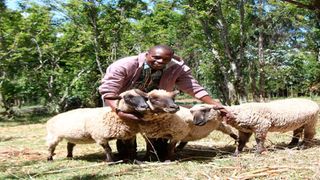
Simon Mungai on his farm in Mirangine, Nyandarua County.
| Richard Maosi | Nation Media GroupPolitics
Premium
What I have learnt on sheep rearing
What you need to know:
- Mungai traces his love for sheep to 2006, when he was rearing the Red Maasai breed.
- He later invested Sh30,000 on buying Merino sheep first, before switching to Hampshire.
Miiri is a quiet village in Mirangine, Nyandarua County, characterised by a dense vegetation cover and good weather patterns that make potato and maize thrive
Seeds of Gold team was in the area to visit Simon Mungai’s three-acre farm, where he keeps 30 Hampshire sheep, four which are rams, 18 ewes and the rest lambs.
He also grows collard greens (sukuma wiki), African nightshade (managu), lucerne and further keeps some poultry.
Mungai traces his love for sheep to 2006, when he was rearing the Red Maasai breed.
"The breed normally weighs between 30-35 kilos when mature. I would sell them for between Sh7,000 and Sh8,000 but they were not doing well here due to the cold weather," he says.
In 2011, in quest for better returns, he visited a farmer in Mirangine, where he learnt modern sheep farming methods.
"I was able to acquire skills on keeping the right breed for a partiular region, housing, better production of mutton and wool, feeds and feeding programme , breeding and recordkeeping."
He later invested Sh30,000 on buying Merino sheep first, before switching to Hampshire.
Proper ventilation
He also constructed a wooden house for the sheep partitioned into cubicles each measuring one by 1.5 metres and elevated from the ground to keep it warm.
The sheep pen also has a designated area for feeding and resting with proper ventilation. He keeps them under a semi-intensive system, where they graze during the day and are housed in the structure at night.
“Each morning I offer them fodder that include napier, desmodium and sweet potato vines first, alongside crushed maize cobs, concentrates, hay and roughages. Sheep are not selective feeders."
But proper feeding of ewes is key in good delivery of healthy lambs, especially during late pregnancy stages as it ensures a mother has enough colostrum. An ewe calves twice a year.
“With good feeding, a Hampshire ram weighs between 65-70 kilos at two years fetching Sh17,000-Sh25,000 .”
He offers them water after every four hours and deworms them every two months. He also shears them every three months, says the farmer.
For breeding, he sources for a ram from other farmers to avoid inbreeding.
Most of his customers are owners of butcheries and restaurants in Nyahururu and Nakuru town.
Major challenges
“I use social media platforms like Facebook and WhatsApp to market my sheep. Other customers come through referrals. I sell three rams a month.”
One of his major challenges is lack of a good market for wool.
“I pay for up to Sh50 per head for someone to shear the animals but in the market, a kilo of wool goes for Sh10, which is too low.”
Simon Wagura, an animal production specialist from The Country Farm in Nyandarua, notes that Hampshire breeds gain weight faster.
"Their meat quality is also high thus they fetch a good market price," he adds, noting indigenous breeds take time to gain weight.
To gain weight faster, he says a farmer must give the animals a balanced diet consisting of dry matter that enhances faster muscle building supplemented withconcentrates and minerals, key among them calcium and phosphorus.
"Deworming also should be done regularly to cut costs on disease management and nutrient deficiency. It makes them less susceptible to diseases. One should also have good houses to prevent pneumonia.”





